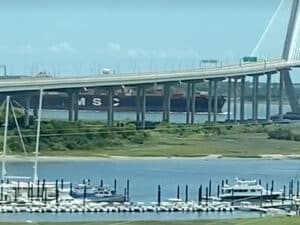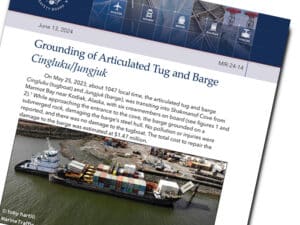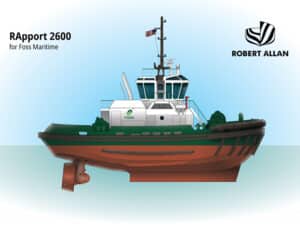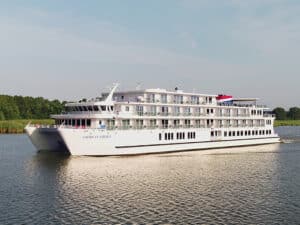
USCG issues interim rule on duck boat safety
Written by Nick Blenkey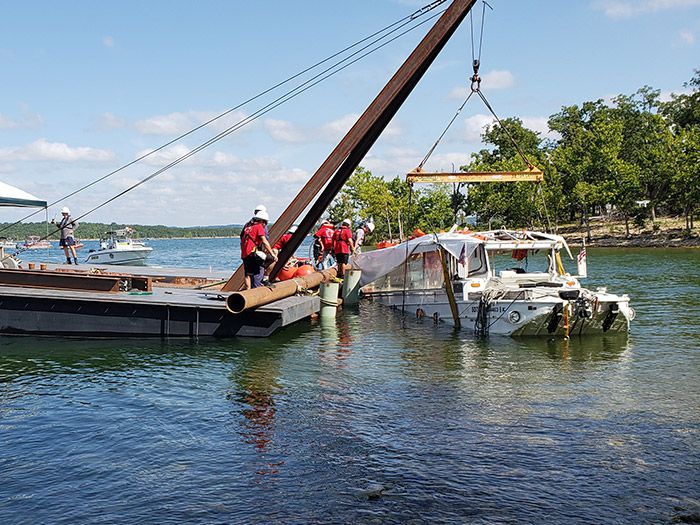
The Coast Guard oversees the removal of Stretch Duck 7 from Table Rock Lake in Branson, Missouri, July 23, 2018 (USCG photo)
The Coast Guard has issued an interim rule as the first step toward implementing statutorily mandated requirements for duck boats — DUKW amphibious passenger vessels. This statutory mandate was enacted after the sinking of the Stretch Duck 7 vessel on July 19, 2018, which resulted in the loss of 17 lives on Table Rock Lake, Missouri. This interim rule requires additional safety measures for DUKW amphibious passenger vessels operating on navigable waters subject to Coast Guard jurisdiction.
The interim rule is effective immediately and duck boat operators will have 120 days from the date of publication to comply with the requirements.
The legal basis for this rulemaking is a section of the James M. Inhofe National Defense Authorization Act for FY 2023 that requires the Coast Guard to implement interim requirements for operators of DUKW amphibious passenger vessels (APVs).
On its passage, that legislation was praised by National Transportation Safey Board Chair Jennifer Homendy, who noted that duck boats were designed and built in the 1940s for military use during World War II, with some being later converted for commercial service.
“They are unique vessels with special challenges that must be addressed to ensure passenger safety,” she said. “They require greater stability and reserve buoyancy, canopy and seatbelt removal before waterborne operations and training for crews.”
“The NTSB first identified these safety issues in 1999 with the sinking of the Miss Majestic in Hot Springs, Arkansas – 21 lives were lost – and recommended corrective actions,” said Homendy. “They were not acted on and again the NTSB made recommendations following the 2018 sinking of the Stretch Duck 7 in Branson, Missouri – after another 17 lives were needlessly lost.”
NINE REQUIREMENTS
Specifically, the 2023 NDAA directs the Coast Guard to require that operators of DUKW APVs comply with nine requirements within 180 days and defines a DUKW APV as a vessel that uses, modifies, or is derived from the General Motors Corporation (GMC) DUKW–353 design, and operates as a small passenger vessel in “waters subject to the jurisdiction of the United States,” as defined 33 CFR 2.38 (or a successor regulation). The nine requirements are:
(1) Remove the canopies and any window coverings of such vessels for waterborne operations, or install a canopy that does not restrict horizontal or vertical escape by passengers in the event of flooding or sinking;
(2) If a canopy and window coverings are removed from any such vessel pursuant to paragraph (1), require that all passengers wear a personal flotation device approved by the Coast Guard before the onset of waterborne operations of such vessel;
(3) Re-engineer such vessels to permanently close all unnecessary access plugs and reduce all through-hull penetrations to the minimum number and size necessary for operation;
(4) Install independently powered electric bilge pumps that can dewater such vessels at the volume of the largest remaining penetration in order to supplement an operable Higgins pump or a dewatering pump of equivalent or greater capacity;
(5) Install in such vessels not fewer than four independently powered bilge alarms;
(6) Conduct an in-water inspection of any such vessel after each time a through-hull penetration has been removed or uncovered;
(7) Verify the watertight integrity of any such vessel through an in-water inspection at the outset of each waterborne departure;
(8) Install underwater light emitting diode (LED) lights that activate automatically in an emergency; and
(9) Otherwise comply with any other provisions of relevant Coast Guard guidance or instructions in the inspection, configuration, and operation of such vessels.

